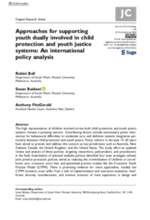The high representation of children involved across both child protection and youth justice systems remains a pressing concern. Contributing factors include unnecessary police intervention for behavioural difficulties in residential care, and deficient systems integration particularly between child protection and youth justice.
Policy reforms in the past 15–20 years have aimed to prevent and address this concern across jurisdictions such as Australia, New Zealand, Canada, the United Kingdom, and the United States. The study offers an updated review and analysis of these policies, targeting researchers, policymakers, and practitioners in the field.
Examination of selected available policies identified four main strategies utilised: joint practice protocols, policies aimed at reducing the criminalisation of children in out-of-home care, crossover court lists, and specialised practice models like the Crossover Youth Practice Model (CYPM). There is promising evidence for some approaches, notably the CYPM, however, most suffer from a lack of implementation and outcomes evaluation, insufficient diversity considerations, and minimal inclusion of lived experience in design and implementation.
Findings suggest future policy reforms should prioritise the development of whole-of-government strategies, involve children’s perspectives, emphasise prevention, restorative and diversionary responses, multi-agency collaboration, ongoing support for implementation, and rigorous evaluation.

